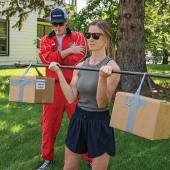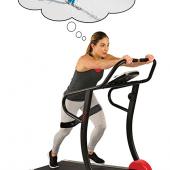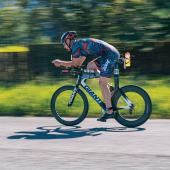Balance for Life
Four years ago I sat down with a potential client to review her medical history and assess her current level of fitness. When I asked if she’d ever broken any bones, she relayed to me a physical history that can only be described as a complete and total train wreck. Her injuries included one broken wrist, ten broken toes, several broken fingers, one destroyed ankle, three herniated discs (still unhealed), and, if that wasn’t enough, she’d been diagnosed with spondylolisthesis—a condition of forward slippage of one vertebrae over another due to wear and tear of ligaments that support the spine. And let’s not forget about the arthritis she eventually developed in her back.
The story of how this Urgent Care aficionado broke her ankle was of interest to me and goes something like this: Twenty-one years ago, as she was descending the stairs on her way to bed, she approached the bottom step and turned her head to look in the direction of the mess in her son’s bedroom. The simultaneous action of turning her head and stepping to the floor from the bottom step caused her to lose her balance, crash to the floor, and shatter her ankle into what she describes as “lots of tiny pieces.” Sixteen titanium pins and one seven-by-two-inch plate later, she could walk but continued to lack something that we all need to function properly...balance.
Physical balance is not dependent on one thing only. Rather, it’s the result of many functions coming together, one of which is described as the “core” structure—also known as the lumbo-pelvic-hip complex, or what I like to refer to as the “internal girdle.” Your internal girdle is made up of lumbar spine (lower back), thoracic spine (middle back), and cervical spine (upper back and neck) working together with the deep musculature area of the trunk, including your spinal erectors, transverse abdominus, internal and external obliques, multifidus, and pelvic floor muscles. Strengthening these attachment muscles can assist in creating better stabilization for the lumbar, thoracic, and cervical spine areas and can even allow us to feel more comfortable and function more efficiently in our personal space.
Core strength isn’t the only thing that can affect balance. As we’ve seen, the simple action of turning your head or closing your eyes while performing another task can cause you to lose your balance. How we see and hear can affect our balance and in turn affects how we feel in the space around us. As we age, vision and/or hearing loss are often responsible for falls. Many times these falls result in single or multiple fractures and are most difficult to recover from at this stage in one’s life.
We can improve our balance, no matter what age, by practicing the simple exercises that follow. I recommend beginning the exercise in its basic form and progressing slowly to the next challenging stage as you’re able. Each stage involves standing on one foot; however, those with severe imbalance issues may choose to place the toe of the opposite foot on the floor.
One-Foot Drill with Progressions
(repeat progressions on opposite foot as well)
-Stand on one foot, arms extended to sides for counterbalance. See if you can hold for 30 seconds or longer.
-Maintain balance and turn head slowly to the left and then to the right. Come back to center.
-Continue standing on one foot and have a partner gently nudge your shoulders, hip, or arm and try to maintain balance.
-Still standing on one foot, close one eye for 10 seconds, open, then close the other for 10 seconds, open, and then close both eyes for 10 seconds. Pay attention to how your body reacts to the loss of vision.
-Standing on one foot, have a partner toss you either a regular ball or a weighted medicine ball. Be sure your partner tosses the ball directly in front of you and then increase the challenge by catching from multiple directions (high, low, right, left).
Each stage of this exercise can be made more difficult by adding a piece of balance equipment. One balance tool, commonly referred to as a Dyna Disc or balance cushion, is very popular because of its size and affordability and can be found in just about any fitness facility. By standing on two discs, one for each foot, you can feel how your body reacts to the instability. You will feel how your core musculature, as well as the stabilizing muscles for your ankles, knees, and lumbo-pelvic complex, all come together to keep you from falling off the discs.
Practicing the simplest of balance exercises can improve how you function in your daily activities as well as improving performance in just about any sport you’re currently participating in. Give it a try. Who knows, maybe someday you’ll be able to sing “head, shoulders, knees, and toes” while actually performing it on a couple of Dyna-Discs!
And what of my accident-prone client? I am happy to report that she has currently lost 40 pounds and will readily admit that she is stronger and more confident at age 50 than she has ever felt in her life. In fact, by practicing balance exercises, creating better core strength, and losing weight, she no longer feels much of the pain she experienced prior to following a regular exercise plan.
Cheryl McDonald, ACSM, H/FI, CPT, is an American College of Sports Medicine–certified health/fitness instructor.










